Table of contents
- Legendary cycling race in Flanders Two motorcyclists follow the route
- Flanders (3)
- Info
- Flanders (2)
- The race
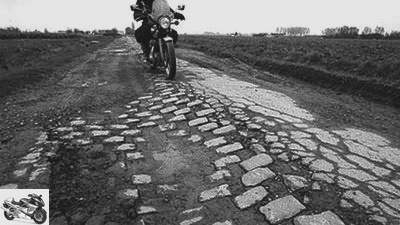
Melkebeek
to travel
Legendary cycling race in Flanders
Legendary cycling race in Flanders
Two motorcyclists follow the route
The legendary cycle race in Flanders is called “Hell of the North”. Held on old cobblestone paths, it is a torture for people and material. Two motorcyclists followed the route through a little-known region of France.
Lothar Kutschera
04/28/2006
It is already evening when Pierre and I arrive in the northern French city of Saint-Quentin. A rough wind is blowing through the streets from the north. Strictly speaking, all I know about Saint-Quentin is that the source of the Escaut River is somewhere here. But at the moment it seems more as if it sprang from somewhere in the sky, because the water falls down in heavy showers. It’s April. Which does not necessarily speak in favor of a rapid change in the weather situation and does not exactly lift the mood. Will be a great expedition if it keeps pouring tomorrow.
In front of us lies the “Hell of the North”, as the classic bike ride between Paris and Roubaix in Flanders is called. However, we are not on the road with racing bikes, but motorized. Whereby motorcycles are connected to the race in a special way? by the journalists, who report in a trembling voice as the passenger while the machines bump over the desert “cat’s head pavement”, as the basalt and granite paths are called here in the lonely north of France. Rhythmically tap your chest as you speak and watch legends arise. It is still the case that on the paved sections of the track, the ?? secteurs paves ??, often no cars can get through to accompany the race and the ?? Motards ?? also take over the technical service of damaged racing cyclists and chauffeur spare bikes. These bad paths, which often consist only of fragments of the old pavement and swing almost romantically between the muddy fields of North Flanders ?? we want to discover them. You are the last adventure in the north.
The start of the race is not, as the superficial viewer might think, in Paris, but around 50 kilometers north of the capital in Compiègne. The traffic on the streets around Paris, which has changed a lot since the first event in 1896 and became more and more hectic, probably forced the starting point to be relocated to the north.
Buy complete article
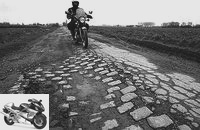
Flanders
The Paris-Roubaix race
12 pages) as PDF
€ 2.00
Buy now
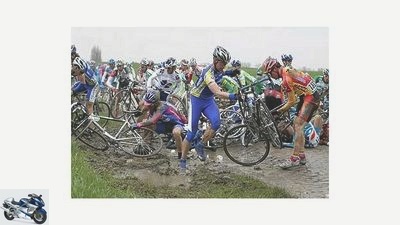
Kutschera
A win at Paris-Roubaix is particularly valuable for professional cyclists.
The first 50 kilometers to Saint-Quentin are rather unspectacular in the race, the speed is high, and the chains are still buzzing well-lubricated over the wreaths. On wide, well-paved roads it goes towards the dreaded “cat’s head” routes. This stage has no special significance in the race. The professional cyclists first curl up before they get down to the nitty-gritty 40 kilometers. The first kilometers to Compiègne are not a challenge for motorcyclists either. And from a tourist point of view, the N 32 national road does not have too much to offer either. We start right away in Saint-Quentin, where, according to the travel guide, not only is the source of the Escaut, but also where Saint Kwinten or Quintus was murdered in 287. Thanks to his presence around 1,800 years ago, we can now enjoy the view of one of the most beautiful cathedrals in France from our hotel room, which was built on this site around 800 years after the murder. In addition, Saint-Quentin is the unofficial capital of the Vermandois, the Vermandland, and was once the fortress of the Viromandui ?? of a Celtic people who, like everyone else, were badly mistreated by the Romans, with the exception of the village community of Asterix and Obelix.
In a nearby restaurant we ponder the possible route of the race, trying to transfer the organization’s road book onto the Michelin map. Not easy, since such a route description is apparently mainly aimed at people who already know the way: the drivers themselves, the accompanying caravan and the local population who want to see the divine pilot pass. And who already know what it should mean when somewhere ?? VO Debut du secteur pave de Quievy à St. Python ?? stands. In the absence of more in-depth descriptions, we end up rhyming most of the route together. Whether we will really find her tomorrow is another matter.
Flanders (3)
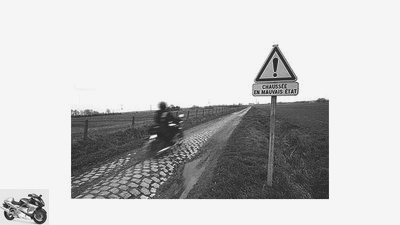
Melkebeek
For those who haven’t noticed: the sign warns of bad road conditions.
At Cafe de la Paix in Querenaing near Valenciennes we are 75 kilometers from Saint-Quentin. It’s late in the morning, aperitif time and the restaurant is packed. The motorcycles are immediately the theme of the guests. We have to explain what we are looking for in this completely untourist area. ?? Ah, Paris-Roubaix! ?? Immediately the faces brighten and a lively discussion breaks out. Where the race was going this year, where it was last year and where the year before. To make the search easier, the host gives us an official route description. Because if we keep poking around, we won’t be able to reach Roubaix today. Half a day around and still 130 kilometers in front of the front wheel. In addition, the lion’s share of the “cat’s head” routes, which are divided into 27 sections and cover a good 50 kilometers of the entire race distance. Fortunately, the route does not go through Valenciennes, but along nice paths around the city. Unfortunately, the most beautiful part of the Arenberg Forest is withheld from us. It is under nature protection, and its extremely lousy slope is only opened once a year. Then, when the racing cyclists experience the ordeal of the year, cheered on by thousands of spectators and fans. A few years ago the direction of travel was reversed. So that the racers now go up instead of down, which rapidly reduced the speed and the number of falls. Even at five to ten motorcycle kilometers per hour, driving is already a questionable undertaking. And downhill at racing speed on tires that are barely a finger’s breadth …
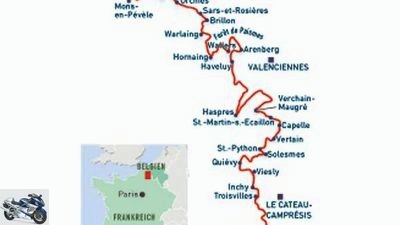
Maucher card
The route gives an impression of the exertion of the racing drivers.
The search for a route remains researching and feeling, sometimes we have the choice between three slopes at an intersection in the middle of nowhere. However, someone always appears who asks in a friendly and astonished manner about our concern: ?? Paris-Roubaix? Aaaaah! Par-là, ils vont par-là, Paris-Roubaix! ?? (Oh, Paris-Roubaix! That way, they’re going that way!).
It is six o’clock in the evening when a huge poster finally welcomes us: “Bienvenue à Roubaix”. After ten hours for barely 200 kilometers, because we skipped the first stretch from Compiègne to Saint-Quentin. Makes a cut of 20 km / h. The racers drive just over 40! When they have reached the finish at the Velodrome in Roubaix, an almost superhuman effort lies behind them. We too made our way through hell. The stretch of motorway back is not enough to get rid of the shaking of the cobblestones. At night I dream of cats’ heads, of every kind. A happy dream as I am not a racing cyclist. Because for many of them, Paris-Roubaix is a nightmare. From start to finish. But they always start again. Every April.
Info
This route hardly offers any tourist highlights. But a good picture of what the French mean when they talk about “Le Nord”: huge fields and arable land, small villages and enchanted cobblestone streets. Paths that have become world famous through a cycling race.
getting there
The area in the extreme northeast of France lies roughly between the English Channel coast and the Belgian border. The start in Saint-Quentin can be reached via the A 26 Metz ?? Reims ?? Calais motorway, the destination in Roubaix on the outskirts of Lille via the A 14 and 19 from Brussels. Travel to the region from Germany either via Saarbrucken or Aachen.
Stay
Accommodation can be found at the starting point in the pretty town of Saint-Quentin. Information at www.tourisme-saintquentinois.fr. The destination in Roubaix with a seamless transition to the metropolis of Lille, on the other hand, is rather unattractive and in some parts of the city even dangerous. To spend the night, it is better to go to medieval Tournai in Belgium, 20 kilometers away. Hotel tips and information at www.tournai.be/fr/commerces.
The distance
Strictly speaking, this tour is more recommended for enduro riders, but with a sprightly street motorcycle and a bit of driving routine, all sections of the route are feasible. Only heavy tourers or athletes can have problems. However, extreme caution is generally advisable. Don’t let yourself be tempted to go faster, even on sections of the route that don’t seem so bad at first glance. Because deep holes or washouts, which sometimes appear all of a sudden directly in front of the front wheel, have to be reckoned with all the time. Make sure to fill up at the beginning of the tour, because there is no longer any supply on the way! It is particularly difficult on Sundays as most petrol stations are closed and machines can often only be operated with French bank cards.
Original route
The route is the original route of the cycling race on April 9, 2006. Theoretically, the route can be downloaded from www.letour.fr/stf/roubaix/2006/us/parcours.html. Practically, however, hardly anything can be seen on it. If you want to follow the route exactly, you should draw our sketch on a detailed road map, such as Michelinblatt 302 in 1: 150,000 or the older 1: 200,000 maps.
Flanders (2)
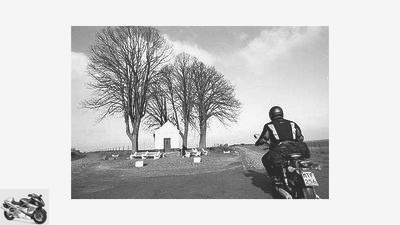
Melkebeek
The Kawasaki W 650 gets along with the roads better than its driver.
On Sunday morning the sky is bright blue, and a brave spring sun is already evaporating the moisture. The end-of-town sign for Saint-Quentin passed quickly, and we don’t yet know that everything that somehow resembles a city is behind us. On the winding connection to Bohain-en-Vermandois we turn the gas properly, ?? Highway To Hell ?? already booming in our heads. We refuel behind the small village. To be on the safe side, Sunday means a petrol shortage in France like during an oil crisis. Also, the area doesn’t look like we could expect a lot of service points. The gas station attendant makes it clear why the Parisians don’t have much to do with the poor north, which is battered by structural change: He’s very friendly, but we absolutely don’t understand whether he speaks French or Viromanduïsch. A little later the first announcement appears: a signpost to Troisvilles, where the Rue de Sucrerie, roughly translated as Zuckerwerkstrasse, is the entrance to hell. Nothing is sugar-sweet here, but the first? Cat’s heads ?? spread. The adventure begins!
A few paved stretches later we have already lost contact with the ground several times with both wheels and set the limit for the suspension elements. Not like Valentino Rossi in the Grand Prix, but by means of a terrifyingly deep hole in the road surface that only appeared at the last moment in front of the front wheel. We are in the real “cat’s head” territory. We are beginning to understand more and more why a lot of professional cyclists are not keen on this competition and the cup ?? By the way, a stylish cobblestone ?? likes to pass by. If the code of honor for this race were not so high, there would probably have been no participants for a long time.
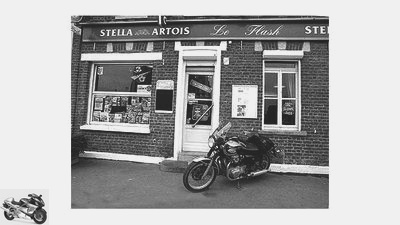
Melkebeek
Typical restaurant: “Le Flash”.
And the locals can only wonder what two motorcyclists are looking for on the bumpy stretches of this classic bike ride. Whenever we get entangled in the abysses of the road book and ask for directions, they kindly guide us back to the asphalt stretches. When we ask whether there is another connection, we usually hear a doubting ?? Oui, mais … c ?? est pave très mal, monsieur … ?? (Sure, but it’s very, very badly paved …). They themselves prefer to drive on the departmental and national roads instead of ruining their cars on the shorter “cat’s head” connections. The stone story is paid more credit here than probably anywhere else in the world. With the exception of the former GDR, perhaps.
Curiously, the press release reads like a friendly invitation to a tourist excursion through two old French provinces and four departments. From Île-de-France to French Flanders, it goes through pompous landscapes with majestic poplars, cornfields and medieval “belfortes”, where history is breathtaking. You could jump right on the bike, couldn’t you? Well, those who actually do that will painfully find out after a short time that reality feels much less distinctive than the description. Even on a motorcycle, the tour is not a Sunday excursion. Sure, you have no problems with the rest of the traffic, as none exist. Correct assessment of curves is not the problem either. Instead, all focus here is on the optimal line, if you don’t want to ruin the motorcycle or end up in the ditch unexpectedly. Our admiration for the motorcyclists who carry referees, signal transmitters, cameramen, photographers, reporters or spare wheels on the pillion during the race increases with every minute. And the one for the cyclists, who torment themselves unsprung and muscular on the downright inappropriately bad roads, every second.
But the press release also contains some truth. That this expedition over the old cart tracks of the north of France ?? which often represent the shortest connection between the places and were probably the only one for centuries ?? offers more possibilities than just taking a look at what hell is like. They offer a journey into a past only 60 years ago, where large parts of Europe could hardly be traveled more comfortably.
The race
The classic Paris-Roubaix, which is part of the Pro Tour for professional cyclists, was held for the 104th time on April 9, 2006 and won by the Swiss Fabian Cancellara. The event took place for the first time in 1896, won by the German Josef Fischer with an average speed of 30.162 km / h, but was canceled several times during the two world wars. The Flemish racing drivers Roger De Vlaeminck (four wins), Rik Van Looy and Eddy Merckx, the French Octave Lapize and Gaston Rebry and the Italian Francesco Moser (all three wins each) became famous here. Since the race is feared by the drivers, the winner becomes a little more of a legend every time. The route gives an impression of the exertion of the racing drivers.
Related articles
-
to travel Flanders Flanders Hot patch The Tour of Flanders in the Belgian province is one of the toughest cycling races in the world. With the enduro on…
-
Over the mountain race routes in Franconian Switzerland
fact to travel Over the mountain race routes in Franconian Switzerland Life: Over the mountain race routes in Franconian Switzerland It’s a pleasure to…
-
PS-TuneUp Triumph Daytona 675 race track tuning
Feulner 17th pictures Andreas Feulner 1/17 PS-TuneUp has set itself the task of forging a good racing athlete into a hot race track sweeper with the…
-
Sascha Feuster 14th pictures Tobias Beyl 1/14 Test bench: Before the race, every moped had to be tested on the mobile test bench for measurements. Sascha…
-
Ice race Krumbach – a very special race in the snow
Henniges Sports & scene Events Ice race Krumbach – a very special race in the snow Ice race Krumbach A very special race in the snow Every winter an icy…
-
Race Flex 2: Vario fork bridge for racing use
Kilianski counselor technology & future Race Flex 2: Vario fork bridge for racing use Race Flex 2 Vario fork bridge for racing use The new Race Flex 2…
-
Race report IDM 2021 Oschersleben
Dino Eisele Sports & scene Motorsport Race report IDM 2021 Oschersleben Race report IDM 2021 Oschersleben Capricious weather, explosive races, surprises…
-
The most beautiful race track in the world: Bikers Classics in Spa 2012
Hecker 26th pictures Hecker 1/26 The perfect weekend – Bikers Classics in Spa. Hecker 2/26 A fairy in the neighbor’s box: Wendy Newton from California…
-
IDM 2021 race report from Most
Dino Eisele Sports & scene Motorsport IDM 2021 race report from Most IDM 2021 race report from Most Change of leadership in the premier class Who will…
-
NitrOlympX dragster race in Hockenheim
Jahn 15th pictures Jahn 1/15 The Briton Ian King powers his nitromethanol-fired dragster out of burn-out. The seven-time top fuel champion adorns himself…